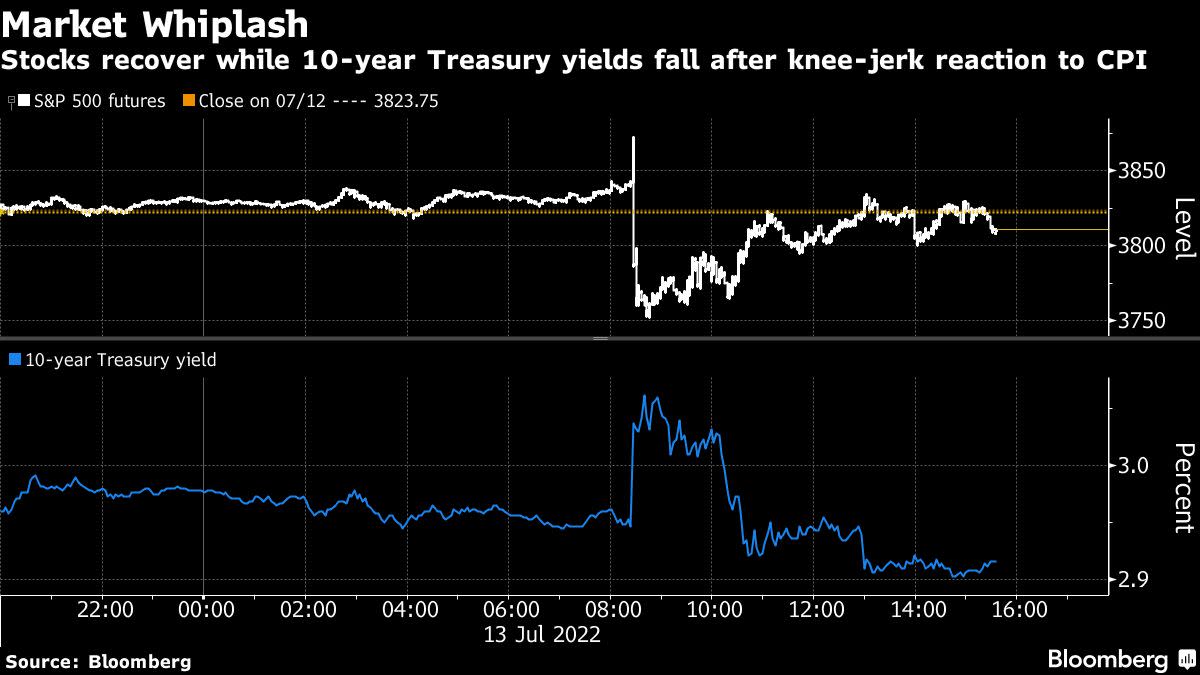
(Bloomberg) — Data that landed like a gut punch on anyone hoping inflation had receded was received with notable poise by investors. Why that happened was the subject of frantic speculation Wednesday on Wall Street.
While odds of draconian rate hikes jumped, so did shares of semiconductor producers, retailers and automakers. Tech stocks as tracked by the Nasdaq 100 Index swung almost 3% from their lows as Tesla Inc., Amazon.com Inc. and Nvidia Corp. ended firmly in the green.
Market strategists hastily revised decidedly dour takes that flowed in the immediate aftermath of the consumer price index’s 1.3% monthly gain. Everything from valuations to stale data to a belief that the worst is over were mentioned to justify the moves.
“Cross-currents galore, all day,” said Alon Rosin, Oppenheimer & Co.’s head of institutional equity derivatives. “Positioning and sentiment is the main driver.”
The Nasdaq 100 reversed a 2.1% decline to slip just 0.1% at the close. As much as anything, analysts pointed to the already-formidable repricing that has occurred in tech stocks this year in explaining Wednesday’s rebound. The index had lost a third of its value from its recent peak after traders dumped richly valued stocks as the Fed’s inflation-fighting resolve stiffened.
At 20 times forecast earnings, the Nasdaq 100 is trading near the lowest multiple since the aftermath of the pandemic crash. To JPMorgan Chase & Co. strategists led by Marko Kolanovic, bargains are emerging in beaten-down corners where sales growth is expected to outrun the rest of the market in the long term.
“The upward repricing of bond yields was a constraint for the valuations of the long duration part of the market, but that could temporarily ease,” the strategists wrote in a note Monday. “Many growth groups’ valuation metrics have moderated.”
Bond traders raised wagers that the central bank could boost rates by a full percentage point this month after a hotter-than-expected inflation reading. One potential silver lining cited by traders is that with the Fed front-loading jumbo hikes, this tightening cycle could end earlier than previously anticipated. Indeed, Treasury futures now embed expectations that interest rates will peak in January. A month ago, the top wasn’t expected until June of next year.
Others argued June’s inflation reading likely marked the zenith of this inflation wave, especially after commodity prices plunged in recent weeks. In a sign that the Fed’s policy is working as planned, expectations for future pricing pressure has eased in the bond market. So-called breakeven rates on Treasury inflation protected securities are pricing in an average annual rate of around 2.33% for the coming decade, near a 10-month low.
“The rates market has said loudly and clearly, it thinks the Fed is going to be more aggressive — but as a result of that more aggressive prediction, it will be successful sooner,” said Mike Zigmont, director of trading and research at Harvest Volatility management.
With short-dated Treasury yields spiking in response to the hot inflation print, the spread between 2-year and 10-year bonds went deeper into inversion, a widely watched signal for a potential recession.
Amid louder warnings from the world of bonds, the equity market stayed sanguine. The S&P 500 wiped out a 1.6% decline before fading into the close, while the Cboe Volatility Index, or VIX, edged lower.
A lot of bad news has been priced into equities. As of Friday, the S&P 500 reflected a 72% probability of an economic recession, compared with odds of 28% showing in Treasuries, according to a model by JPMorgan.
The retreat in the 10-year Treasury yield — a gauge widely used in equity discount models — is adding support to growth stocks, according to Dennis DeBusschere, the founder of 22V Research.
That may not be good news to investors who have shunned growth stocks in favor of cheap, economically sensitive shares like energy producers. In Bank of America Corp.’s survey last month, a net 65% of money managers expected value to outperform, the most ever.
“Markets higher led by growth on a CPI number that was much higher than expected,” said DeBusschere. “That equals pain trade.”
While inflation is the biggest enemy of bonds, the impact on stocks is more nuanced, especially when it comes to corporate profits. Yes, rising input costs threaten to erode business profitability, as in the case of Delta Air Lines Inc. Though companies like PepsiCo Inc. have been able to raise prices amid resilient consumer demand.
While stubbornly buoyant profit estimates from analysts during the equity rout are widely viewed as dubious, they remain one vote of confidence in corporate America’s earnings power.
“The recovery is based on the belief that the June CPI reading was peak inflation and July numbers will be better,” said Larry Peruzzi, the head of international trading at Mischler Financial Group Inc. “But we need to take that thinking cautiously as we are only 13 of 31 days into the month. Things could reverse quickly.”
©2022 Bloomberg L.P.